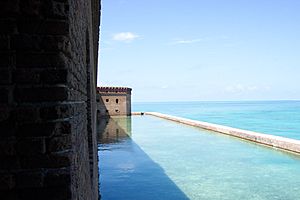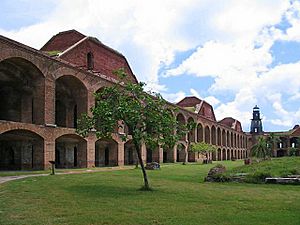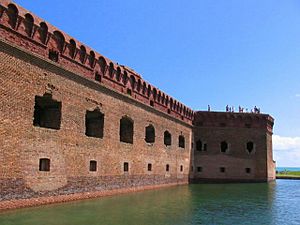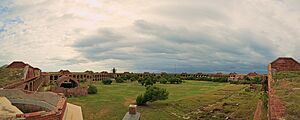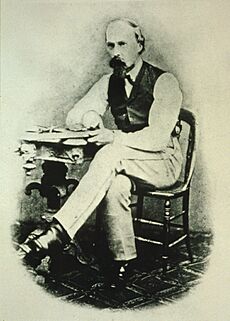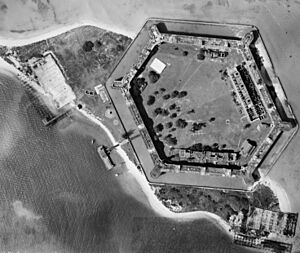Fort Jefferson (Florida) facts for kids
Quick facts for kids |
|
|
Fort Jefferson National Monument
|
|

Aerial view of Garden Key and Fort Jefferson
|
|
| Location | Dry Tortugas, Florida, 68 miles (109 km) west of Key West in the Gulf of Mexico |
|---|---|
| Area | 47.125 acres (19.071 ha) |
| Built | 1847 |
| NRHP reference No. | 70000069 |
| Added to NRHP | November 10, 1970 |
| Fort Jefferson Prison | |
|---|---|
| Part of American Civil War prison camps | |
| Dry Tortugas, Florida, U.S. | |
| Type | Union Prison Camp |
| Site information | |
| Owner | U.S. Government |
| Controlled by | Union Army |
| Site history | |
| Built | 1861 |
| In use | September 1861 – April 1, 1869 |
| Battles/wars | American Civil War |
| Garrison information | |
| Past commanders |
Colonel Bill Wilson |
| Occupants | Union soldiers, Confederate prisoners of war, civilians |
Fort Jefferson is a huge old military fort located in the Dry Tortugas National Park in Florida. It's the biggest brick building in all of North and South America! The fort covers about 16 acres (6.5 ha) and was built with over 16 million bricks.
Only two other forts in the United States are larger: Fort Monroe in Virginia and Fort Adams in Rhode Island. Fort Jefferson sits on Garden Key, an island in the lower Florida Keys. It's about 68 miles (109 km) west of Key West. The Dry Tortugas islands are part of Monroe County, Florida.
Contents
History of Fort Jefferson
Why Was the Fort Built?
Back in the early 1800s, after Florida joined the United States, the U.S. Navy looked for a good spot to build a naval base. They wanted to stop pirates in the Caribbean Sea.
In 1825, a naval officer named David Porter checked out the Dry Tortugas islands. He didn't think they were good for a naval base. He said they were just small sand islands with no fresh water. He also thought the ground wasn't strong enough for a fort.
However, other government officials saw the islands differently. They thought the Dry Tortugas would be a great place for a lighthouse to guide ships. A small island, later called Garden Key, was chosen. The Garden Key Light was built there between 1825 and 1826. It was 65-foot (20 m) tall and made of brick.
Later, in 1829, another officer named John Rodgers found the Dry Tortugas to be a perfect spot. He saw that the islands had a safe harbor for many ships. He realized that if an enemy took over the Dry Tortugas, they could easily attack U.S. ships in the Gulf of Mexico. But if the U.S. fortified the islands, they would be a strong defense for the Gulf Coast.
Robert E. Lee, who was a Captain in the U.S. Army at the time, agreed. In 1845, the Dry Tortugas officially became a national military area.
Building the Giant Fort
Construction of Fort Jefferson began in December 1846 on Garden Key. It was named after the third U.S. President, Thomas Jefferson. The fort was designed by important engineers like Joseph Totten and Montgomery C. Meigs.
The work was about half-finished by 1860. Many of the workers were enslaved people whose owners in Key West were paid for their labor. Some White workers, often Irish immigrants, also helped build the fort. The use of enslaved labor stopped in 1863.
The original Garden Key lighthouse and its keeper's house were actually built inside the fort's walls. The lighthouse kept guiding ships until a new metal light was placed on top of the fort in 1876. The old brick lighthouse tower was then taken down.
Fort Design and Features
Fort Jefferson was designed with six sides and two levels of gunrooms, called casemates. Two of the walls were 325 feet (99 m) long, and the other four were 477 feet (145 m) long. At each corner were large projections called bastions. These allowed soldiers to fire along the walls for defense.
Each level of gunrooms could hold 150 guns. Another 150 guns could be placed on top of the fort. These heavy guns were mounted inside the walls, pointing out to sea through large openings called embrasures.
The fort's central area, known as the parade ground, was about 13-acre (5.3 ha) in size. It held places for storing gunpowder, the fort's headquarters, a hospital, officers' living areas, and three large barracks for soldiers.
Building such a large fort on an island with no fresh water was a challenge. An clever system of cisterns was built into the fort's walls. These were meant to collect rainwater from the roof and filter it through sand columns. However, the sand made the water salty, so it was only good for washing and cooking. Drinking water came from rainwater collected under the parade ground. Later, during the Civil War, special machines could turn 7,000 US gallons (26,000 L) of sea water into fresh water every day.
Fort Jefferson During the Civil War
When the American Civil War began, soldiers from the U.S. Army were sent to Fort Jefferson. This stopped the fort from being taken by rebel forces. The fort's heavy guns were first fired on January 26, 1861, as a test. At that time, 168 people lived at the fort, including women and children.
More soldiers arrived to guard the fort. In September 1861, the first prisoners arrived. These were soldiers who had been found guilty of breaking military rules. President Abraham Lincoln even sent soldiers who had deserted (left without permission) to be imprisoned at the Dry Tortugas instead of being executed.
By 1863, most of the enslaved workers had left after the Emancipation Proclamation. The fort then used military prisoners for much of the hard labor. By 1864, there were almost as many prisoners as soldiers guarding them.
After the Civil War
On July 24, 1865, four special civilian prisoners arrived at Fort Jefferson. These men, Samuel Mudd, Edman Spangler, Samuel Arnold, and Michael O'Laughlen, had been found guilty of being involved in the assassination of President Abraham Lincoln.
Samuel Mudd tried to escape on a ship, which led to him being held in the fort's "dungeon." Above the dungeon entrance were words from a famous poem: "Whoso entereth here leaveth all hope behind."
In 1867, a terrible yellow fever epidemic hit the fort. Many prisoners died, including Michael O'Laughlen. Dr. Mudd, who was a physician, helped care for the sick during this time. A monument to the fort's surgeon, Joseph Sim Smith, who also died in the epidemic, is still on the parade grounds. Later, President Andrew Johnson pardoned Mudd, Arnold, and Spangler, and they were released.
The fort's outer wall, called the seawall, was finally finished in 1872. The fort had 243 large guns, but they were never fired in battle.
Because of frequent hurricanes and yellow fever outbreaks, the Army decided to remove most of the soldiers in 1874. Only a small group remained to look after the weapons. In 1889, the Army gave the fort to the Marine Hospital Service. They used it as a quarantine station, where people who might be sick could stay to prevent diseases from spreading. The U.S. Navy also used the key to refuel their ships.
Over time, Fort Jefferson began to fall apart. It was neglected, damaged by storms, and vandalized. It stayed empty until the Spanish–American War in 1898. The American fleet used the fort as a base during this war. The famous ship USS Maine even loaded coal there before its trip to Havana.
In 1902, the fort was given to the Navy Department. They built coal stations and water-making plants. But hurricanes destroyed these in 1906, and the fort was abandoned again. Two years later, the islands became a federal bird reservation. Until 1934, Garden Key and the fort's ruins were mostly visited by fishermen and tourists.
During World War I, the lighthouse was no longer used, but a wireless radio station and a naval seaplane base operated there.
Becoming a National Park
On January 4, 1935, President Franklin D. Roosevelt made the area a National Monument called Fort Jefferson. From 1935 to 1938, a program called the Works Progress Administration helped repair and preserve the fort.
Fort Jefferson was added to the National Register of Historic Places on November 10, 1970. Then, on October 26, 1992, the Dry Tortugas, including Fort Jefferson, became a full National Park.
Visiting Fort Jefferson
You can reach Fort Jefferson by taking a daily ferry from Key West. You can also get there by chartered seaplane or private boat. If you visit, you can camp on the beach.
Most visitors who come by ferry spend about four hours on the island. This is enough time to take a guided tour of the fort, eat lunch on the boat, and even go swimming or snorkeling in the reef. The fort also has a museum and a bookstore where you can learn more.
|


